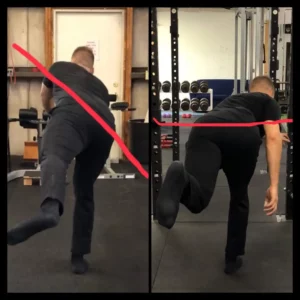The single leg deadlift is a fantastic exercise. Not only is it good at building strength in the lower body and ingraining the hinge movement, it also develops single leg stability, is easy on the lower back for those with a history of lower back pain, and helps eliminate imbalances in the lower body.
However, the main reason I love the single leg deadlift is that it is a great movement screen as well. If you can properly perform a single leg deadlift, you are demonstrating to me as a coach that you possess the requisite foot stability, ankle mobility, knee stability, hip mobility, and trunk stability required to perform most movements.
These are all requisite characteristics of the joint by joint approach created and popularized by Gray Cook and Mike Boyle. If you are unfamiliar with the concept of the joint by joint approach, you can read more about it here.
Simple, Not Easy.
Ironically enough, the SLDL is a movement I have notoriously struggled with in the past due to my own movement limitations. As a result, I have spent way too much time trying to hack this movement and find the proper progressions and regressions to get the most out of it.
The biggest issue I have is keeping my hips squared throughout the movement. I have the tendency, like many others, to let my knee dive in and my hips open up. This happens specifically on my right side, where my hip is limited in external rotation and way too happy to take an internally rotated position.

A cue I sometimes use with clients to keep the hips squared is to turn the toe of the back leg in. This helps create a slightly internal position of the trail leg femur, which combined with the external rotation of the front leg femur creates a stable pelvis position and hips that don’t, or shouldn’t, rotate.
However, for those that are severely limited such as myself, this cue sometimes doesn’t work. Instead we have to break the movement down and regress the pattern so that it can be built back up with a more stable base.
Enter the Single Leg Deadlift with a cross reach.
Cross Reach Single Leg Deadlift
Adding a cross reach to this movement allows you to keep the hips square even if that is something you struggle with. As a result, it lets you achieve a better hip and knee position which allows for proper technique to be achieved. The first time I did these not only did it clean up the pattern, it also allowed me to sit back into my hip like I never could have prior to learning this drill. Sure enough, the next day my glute medius (a lateral stabilizer of the hip) was sore to the touch. Something started to work that certainly wasn’t before.
Once mastering the cross reach and learning how to keep the hips squared, the SLDL can then be progressed and loaded as long as that mastery is maintained. This will set you up to build bullet proof hips and knees as well as a damn good hinge pattern that will translate into many other movements you perform in training.
If you have trouble with your hips opening up in the single leg deadlift, give this drill a shot and let me know what you think.




